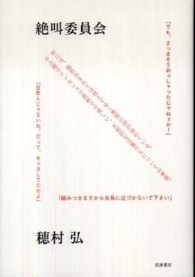- ホーム
- > 洋書
- > 英文書
- > History / World
Full Description
Shining a light on some of the most interesting research results on megalithic cultures, as well as their contemporaries, these 16 papers from the European Megalithic Studies Group symposium (Santiago de Compostela, Spain), cover monuments from Germany, moving down the Atlantic Facade across to Ireland and then back to the Western Mediterranean. Issues presented in this volume include temporality and mobility (both at the broad scale and at the local scale), social organisation & settings and external relationships. The methods used to investigate these themes are various: bio-molecular and isotopic analyses, typo-chronology, targeted excavations & radiocarbon dating, material cultural analyses, 3D models, ceremonial & funerary/burial practices (including osteometrics) and large-scale prospection. New methods researching the materiality and symbolism of monuments are also presented; some incorporate the role of the natural world. Alongside them are other contributions focusing on the key characteristic of megalithic monuments - the skilful and purposeful arrangement of large blocks of stone - and their interpretation. Discoveries include the intriguing return of large & complex ceremonial timber circles in active megalithic areas, presenting a significant contrast to what was considered the main funerary expressions in South Portugal. Ultimately, through the application of new, or differently applied, technologies and ways of thinking, this volume offers a series of studies that remove some of the mystery that surrounds these mementos of another time.
Contents
List of editors and main affiliations
List of Symposium Speakers - Talks listed if no book chapter
List of Volume Contributors (Alphabetical)
List of chapter reviewers
List of Figures and Tables
Preface
Chapter 1: Time, mobility and society: new approaches to megalithic monumentality in western and northern Europe - Chris Scarre
Chapter 2: Towards a High-Resolution Chronology of Major Megalithic Monuments: Menga and Montelirio (Andalusia, Spain) - Leonardo García Sanjuán, Marta Díaz-Guardamino and Francisco José Sánchez-Díaz
Chapter 3: Dissolving and contrasting. The secondary deposition of human cremains at Perdigões enclosure (3rd millennium BC, South Portugal) - Antonio Valera and Lucy Shaw Evangelista
Chapter 4: Para-megalithism: alternative routes to understanding big stones - Jessica Smyth
Chapter 5: Funnel Beaker Culture megaliths in northern Germany. A comparison of architectural elements between three regions - Anja Behrens
Chapter 6: Sardinian megalithic and rock-cut tombs in the context of the prehistoric western Mediterranean - Maria Grazia Melis
Chapter 7: Megaliths: the singularity of each element. Appropriation of distinct entities versus geometric constructions - Luc Laporte
Chapter 8: Current Research on Westphalian Megaliths - Kerstin Schierhold
Chapter 9: Preserved and demolished megaliths from the Danish Funnel Beaker Culture - Niels H. Andersen
Chapter 10: 'Linking megaliths'. A computational approach to the study of movement and mobility in the megalithic complex of Galicia (Northwest of the Iberian Peninsula) - Miguel Carrero-Pazos and Devin A. White
Chapter 11: Multi-method geophysical survey in megalithic landscapes: case studies from Ireland and Sweden - Stephen Davis, Tony Axelsson, Knut Rassmann and Karl-Göran Sjögren
Chapter 12: Geoglyphs, petroglyphs, and megaliths - Richard Bradley
Chapter 13: Building Space. A Structural Model of Space in Megalithic Landscapes - Felipe Criado-Boado and Jadranka Verdonkschot
Chapter 14: Fathoming megaliths: social proxies and indictors for the study of the dolmens - Gail Higginbottom
Chapter 15: A Reappraisal of Megalithic Orientations from Iberia and beyond: towards models of interpretation - A. César González-García
Chapter 16: Monuments of the Dynasties - Monuments of the People? Megaliths in Europe - Johannes Müller








